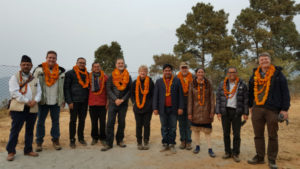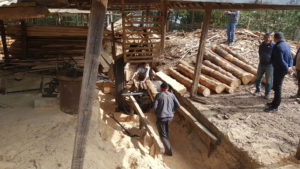Centre for Global Food and Resources (GFAR) Associate Director of Agribusiness Innovation, Mr. Craig Johns recently visited Nepal for the inception meeting of a new project on forestry management. Craig narrates his experience in this blog.
What a fascinating country Nepal is! While this was my first trip into Nepal, I am joining a dedicated team looking to expand on the successful outcomes of a previous forestry project. The new Australian Centre for International Agricultural Research (ACIAR) project entitled ‘Enhancing livelihoods from improved forest management in Nepal’ or ‘EnLiFT2’ for short, is led by Dr. Ian Nuberg of School of Agriculture, Food and Wine and draws on research skills from across 3 faculties of the University of Adelaide , University of New South Wales and includes a host of inspiring in country Nepal based partners. The project has three core areas of research covering the silvicultural techniques required to manage the forests, the planning and governance systems to balance livelihood, social and environmental needs and the forest enterprise models to enhance the benefits all the way along the value chain. While I’ll be focusing my efforts mainly on the third area, the theme of the inception meeting last week was very much around the collaborative nature of this project and how all 3 areas of research will work together towards a common goal.

Project team from ACIAR, University of Adelaide, University of NSW and ForestAction
As a bit of background, the Middle Hills of Nepal are home to 44% of the country’s population, of which 66% derive their livelihood from a combination of agriculture and forest products. Under the Nepal Forestry Program, 25% of forest land has been handed over to 19,000 Community Forest User Groups (CFUG’s). During this trip I was able to meet with the leaders of one of these community groups and was very impressed with their operation. They manage a total forestry area of 73 hectares, which supports 289 households. Their operational plan includes not only how they manage the forest, but also how they invest the proceeds of any timber sales and share this wealth throughout the community. These activities include infrastructure projects on house construction, water access, solar lighting and road repairs as well as putting aside separate funds for administration, education, training, health, sport, security and even a specific disaster fund.

A sawmill in the Middle Hills which is processing the logs into timber products
While this particular CGFUG is functioning at a very high level, there are opportunities for this project to expand this model out and enhance the silvicultural, regulatory and market opportunities across the whole industry. I’m certainly looking forward to reporting back on our activities and outcomes as the project progresses.

